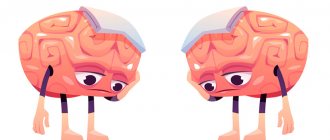Obsessive-compulsive disorder or, in other words, “obsessive neurosis” is a fairly common mental illness, which is a clear manifestation of borderline mental disorders. The approved medical name for this disease has two Latin roots: obsession and compulsion.
Obsession, translated from Latin, means “possession”, and in the aspect of this disease - an obsessive thought or idea. Obsessive thoughts of an OCD sufferer most often contain a scary, unhealthy and unpleasant idea in their content, and can also be aggressive in nature.
Compulsion is interpreted as an “obsessive action”, and according to its symptoms, it consists of permanent double-checking of everything: whether the door is closed, whether the appliances are turned off, whether hands have been thoroughly washed.
In simpler terms, OCD implies obsessions of any pathogenesis that literally prevent a person from living. Sick thoughts lead the patient to the need to constantly repeat the same actions, bringing the situation to the point of absurdity. For example, a patient with an internal fear of infection may “wash his hands” until he wipes them until they bleed. A patient with a compulsion to double-check may return home many times to check household appliances, or read the same page of a book a million times in an effort to find out how much time he spends on it. Of course, such a scheme of being reduces the quality of life, exhausts and torments a person, and ultimately leads to stressful conditions and neuroses.
We will look at how to live with this and what self-help methods you can use below in this article. In the meantime, let us pay attention to the etiology of the formation of this disease. What can serve as a trigger for the development of obsessive-compulsive syndrome.
Reasons for the development of OCD
The formation of the disorder is essentially based on three factors:
- A biological factor, including disturbances in the functioning of neurotransmitters, cellular metabolism of the brain or autonomic nervous activity, traumatic brain injury and heredity, and the latter is not the underlying cause.
- Social, which implies strict boundaries and norms imposed on the child in childhood in the family or any other system in which he lived or communicated.
- Psychological includes both character accentuations (pronounced traits that influence the behavioral aspect), as well as traumatic circumstances.
From the point of view of Gestalt psychology, the formation of the disorder is perfectly demonstrated in the famous film “The Aviator”, which, by the way, is highly recommended for viewing by patients with this syndrome. In the case of the main character, two factors were involved: biological (genetic predisposition passed on from the mother) and social (an unhealthy pattern of behavior imposed by her). Every time she washed her child, she said, like a mantra, that there was an infection everywhere, from which everyone was dying. Thus, she transferred her anxiety and overprotection to the child. Thus, in light of the social aspect, the boy grew up in an artificially created environment in which any stressful situation triggered an increase in symptoms with accentuation.
How OCD is formed
In each of us there live instinctive impulses, called by Freud “the unconscious”, and the superego - the “superego”, which, under certain circumstances, come into conflict, giving rise to internal contradictions in the individual. Primordial animal instincts and social censorship, the concepts of “want” and “need”, “possible” and “impossible”, enter into the struggle. And when the confrontation of motives under the influence of the factors stated above gets out of control, the person’s level of anxiety increases and neurosis begins to form. From a psychological point of view, it is increased anxiety that leads a person to obsessive-compulsive disorder. What is anxiety?
In its pathogenesis, it is the fear of the unknown, which in the case of this disorder is associated with the suppression of feelings and emotions in childhood. But the task of the brain is to protect the body from what it cannot cope with, therefore, against the background of anxiety, compensatory mechanisms are activated, ultimately leading to the fact that the patient understands what he is afraid of and is aware of his fear. For example, if a person is afraid of germs, then he goes to wash his hands and as a result of this process he calms down, but obsessive-compulsive syndrome is a kind of addiction, that is, each time a person needs to wash his hands more thoroughly and more often.
Why is this happening? In order to protect itself, the psyche deliberately takes a person to the external, so as not to give him the opportunity to look deep into himself. In a cyclical useless process, the patient's attention is directed to the external ritual process, and is not immersed in the problem and sadness that live inside him. It is so impossible for a patient with this syndrome to be immersed in pain that the psyche transfers it to external details.
Pathogenesis
As a rule, the occurrence of obsessive movements is associated with stress. Autostimulation is a term used to describe frequently repeated movements that help a person with certain developmental disorders cope with stress. This often occurs in autism .
Monotonous movements that are repeated, or a series of such movements, develop as a result of disturbances at the mental and emotional levels. Essentially, these movements are obsessive-compulsive disorder. Today, work is still underway to study the pathogenesis of this phenomenon. There are many theories about it. In particular, the influence on the development of this pathology of a hereditary factor and the involvement of the dopamine system in the pathogenesis of OCD is being studied. The involvement of the norepinephrine and GABAergic neurotransmitter systems in the pathological process is also being studied.
How OCD manifests itself
As noted above, the main symptomatology is the presence of debilitating, repetitive strange thoughts or ideas in the patient, leading, accordingly, to a series of repeated meaningless actions. It is worth noting that a “stray” isolated thought enters a person’s head completely unexpectedly, and at first glance for no reason. But the problem is that it remains there, as if “hanging” and does not go anywhere.
Sometimes the patient begins to feel that he can harm others: push someone under a car on the street, hit someone, cut someone with a knife. Moreover, he tends to constantly double-check whether he was at the scene of any incident, which is due to the fact that a person may not remember the details and sequence of his actions. This is due to the fact that one of the manifestations of the obsession syndrome is the individual’s being in “deep sleep.” Suppressed feelings and emotions immerse the patient in his inner space, which is comfortable and safe for him. That is, a person can walk down the street, ride in public transport or in an elevator and not remember what he did or saw at that moment. The level of awareness in the “here and now” is practically zero, which consequently leads to an obsessive need to double-check everything.
Classification
Experts divide the symptoms of this disease into three types:
- Classic tics are jerky and rapid movements of the head, arm or neck. Their manifestation may be preceded by skin itching. Tics can also be audible. The person constantly clears his throat, snorts or hums.
- Stereotypes – This could be tapping the table with your fingers, rocking to the side, twitching your limbs, or other stereotypical movements. However, there are no warning signs of the onset of such an attack.
- Disorders associated with harm to the body - hair plucking, nail biting, etc.
According to the characteristics of the manifestations, the following stand out:
- Single - the intensity level of such manifestations is the same over a long time, or they gradually fade over time.
- Remitting – symptoms either worsen or fade
- Progressive – symptoms get worse over time.
OCD symptoms
Patterns of behavior of patients depending on the form of manifestation of neurosis.
Adult symptoms essentially represent a single clinical picture in which fears and obsessions, by their essence and the clinical picture of manifestation, can be divided into the following categories:
- Contrasting obsessions : terrible, very vivid pictures that the mind persistently “throws” at the patient. These obsessions may include thoughts about sexual perversion, about killing someone or violence against those who have not done anything wrong to the patient, blasphemous ideas. The patient himself is aware of the horror and irrationality of his thoughts, but is unable to cope with them, take control and get rid of the fear of their translation into reality.
- Fear of infection or disease . Often, the patient sees dirt and pathogenic bacteria everywhere. Theoretically, he realizes that he will not die from this, but the very thought of dirt is unbearable for him. It is this fear that leads to the obsessive desire to constantly wash your hands, rub them with soap and alcohol, and do this countless times. This category also includes agoraphobia or fear of crowds. For patients who are afraid of infection, anxiety increases many times in crowded places, so they try to avoid them.
- “Rechecking” belongs to the category of compulsions and includes a set of such actions that are constantly repeated. The patient may return several times to check again and again whether the appliances are turned off, whether the door is closed, whether he took the change.
- The pursuit of symmetry . A person can spend hours arranging books in alphabetical order or clearing the table every half hour. All these actions serve as a kind of ritual for getting rid of an obsessive state. However, if the patient’s desire to lay out and organize everything around him in a symmetrical order is absolutely uncontrollable and irresistible, then the help of a specialist is simply necessary.
In addition to the above manifestations, symptoms can be conditionally grouped into the following groups:
- physical manifestations - weakness, sleep disturbance, headaches;
- emotional – hypochondriacal neurosis, depression, phobias;
- cognitive – amnesia, memory disorders, problems with diction;
- behavioral – aggressive or apathetic behavior, obsessive actions;
- perceptual – delusions of grandiosity against the background of hallucinosis.
Signs of obsessional neurosis
Among the signs characteristic of the disorder:
- obsessive fears that have no good reason;
- harassing thoughts and judgments;
- obsessions;
- actions of the same type, reminiscent of a ritual.
Patients with OCD may be afraid of getting infected with something, meeting someone, or not liking someone. Many of them have a painful form of perfectionism. Then a person tries to achieve ideal order and cleanliness in everything. The most common “rituals” are checking whether the front door is closed, whether the gas stove or lights are turned off. A sick person may wash their hands too often or look out the window.
Patients often come up with very unusual rituals - for example, they squat three times before putting on their shoes, or turn around their axis several times before entering the apartment. This behavior seems very strange to others.
Stages of OCD
Unlike many other mental disorders and neuroses, the stages of obsessive-compulsive disorder relate more to the level of perception of them by the patient, rather than to the aggravation of symptoms. Thus, almost everyone suffering from OCD goes through three conditional stages:
- Misunderstanding . A state of generally not understanding what is happening. A person begins, out of nowhere, to be disturbed by strange thoughts, and sometimes previously unusual actions spontaneously appear. Of course, all this is extremely frightening and provokes the highest level of anxiety, especially since most likely the person knows nothing about this disorder, and certainly does not allow the possibility of its development in himself.
- Understanding without awareness . OCD is considered an independent unified diagnosis, which is disclosed to the patient. So, a person knows for sure that he has developed this form of neurosis, but he categorically refuses to believe in it, believing that everything will go away by itself, this is how the work of compensatory mechanisms manifests itself. Next, a person often enters into a struggle with his obsessions, to win, which is quite difficult alone; at this stage, it is very important not to lose faith in oneself and to seek help in time. tries to resist his strange
- Adoption . The key period of the disease is when the patient realizes that he has abnormalities and acknowledges their presence, understanding that obsessions are a symptom of a disorder in the functioning of the brain, which needs to be treated using the method of deeper awareness and elaboration.
Of great importance in the treatment of OCD for the patient himself is his possession of information about the pathogenesis, etiology and trigger mechanisms of action of this type of neurosis. The ability and ability to apply self-help methods in the presence of this disorder play a big role, giving a person the opportunity to understand the essence of their fears, and therefore, take control of them and become able to manage their condition.
Survey
If obsessive-compulsive neurosis is suspected, the doctor conducts an examination, survey, and psychological testing. If a psychosomatic disease is detected, the patient is referred for consultation to specialized specialists (hepatologist, gastroenterologist, otolaryngologist, cardiologist, etc.).
The presence of a disorder is indicated by regularly occurring obsessions lasting at least one hour a day. They change a person’s life, make it incomplete, interfere with their ability to perform work duties and study.
Among the diagnostic criteria of the disease:
- increased sweating;
- hand tremors;
- nervous tic;
- involuntary twitching of facial muscles;
- increased tendon reflexes.
If there is a suspicion of organic brain pathology, an MRI or CT scan is performed.
Self-help methods
In the previous paragraph, considering the behavior patterns of patients suffering from obsessive-compulsive neurosis, we classified the forms of the disorder into categories. Based on the nature of obsessions or compulsions, as well as background symptoms, the psychotherapeutic community recommends the following exercises:
The first and fairly common method is internal independent awareness of one’s sick thought (obsession) and recognition of it. The patient can say to himself: “Yes, this is my sick thought, which arose for a number of reasons that I need to neutralize.” How can you neutralize obsession? The awareness-acceptance technique involves an approach of the “knock out a wedge with a wedge” type, when it is proposed to turn your gaze inward and, through visualization, strengthen the situation that causes fear. If a person is afraid of dirt, then he needs to imagine that dirt is literally everywhere, and it is terrible. It is necessary to remain in this state for as long as possible, strengthening and thereby overcoming anxiety. The technique is used in the treatment of obsessions associated with fear of infection.
In a situation with contrasting obsessions and re-checking compulsions, psychotherapy offers a method of total acceptance of being. The patient is advised to imagine what will happen in the worst case scenario and accept it. For example, the iron is still on, which means the apartment will eventually burn down. In other words, you need to accept the finitude of any situation and its consequences.
Anything can happen, whether you think about it or not. The main thing is to be prepared for this.
The approach, by the way, is good in all other cases: whether a person is healthy or sick, whether he is treating neuroses and stress, or whether he feels quite comfortable. Accepting the existential theme that today may be the last day brings high awareness and brings us closer to accepting any circumstances.
Another great DIY method is keeping a journal of feelings and self-reflection, which is a simple way of working with yourself. It consists in the fact that a person writes down everything that happens to him: with whom he communicated, what he said, what he felt, what dreams he had. Details can be written down or drawn, whichever is more convenient for you. Thus, problems are brought into the field of conscious perception and, accordingly, independent control.
Diet
Diet for the nervous system
- Efficacy: therapeutic effect after 2 months
- Timing: constantly
- Cost of food: 1700-1800 rubles per week
In case of neurosis, it is imperative to compensate for the deficiency of minerals and vitamins, since their deficiency can provoke such manifestations. It is recommended to consume the following foods:
- All types of greens, cabbage, asparagus.
- Bananas, citrus fruits
- Liver.
- Fish.
- Seeds, nuts.
- Vegetable oils.
- Meat.
- Sea buckthorn, rose hips, currants.
The following should be excluded from the menu:
- Sweets.
- Mayonnaise, margarine.
- Alcohol.
- Strong tea and coffee, soda.
You should also reduce the amount of foods containing starch in your diet.
Treatment of OCD
As with any other neurological disorder, in severe cases it is necessary to involve a team of specialists (psychotherapist, neurologist, psychiatrist) capable of applying a range of measures, including drug therapy.
During stress caused by an obsessive-phobic state, nerve cells are destroyed much faster, and the functional centers of the brain begin to work less and less. It is impossible to normalize and facilitate this process without the use of medications, which is why patients are prescribed drugs from the class of tranquilizers and antidepressants. When brain activity is more or less restored, the use of a psychotherapeutic approach, which plays a major role in treating the disorder, turns out to be more effective.
Psychotherapy methods
The essence of psychotherapy is awareness and acceptance of your suppressed feelings and emotions. It is important to note that psychotherapeutic treatment is quite multifaceted and includes a number of different techniques. For example, cognitive behavioral therapy leads the patient to recognize the irrationality of his behavior and beliefs. It involves increasing the irritating stimulus by gradually immersing the patient in a stressful situation until the level of reaction decreases. This approach, which we have already touched upon in self-help methods, is called the “exposure method” and has proven itself very well. Behavioral exposure tasks can have different mechanics depending on the symptomatology. When treating obsessions, a person is asked to reproduce a thought intentionally and a certain number of times. If the obsession comes 5 times, then it should be deliberately repeated 10 times, or even better, prescribed. The situation with rituals is similar. By increasing the irritating and frightening factor and deliberately immersing oneself in it, the patient’s symptom goes away, but, unfortunately, the problem itself is not solved. That is why at one stage of cognitive behavioral therapy the techniques of gestalt and psychoanalysis are used.
Gestalt therapy
It consists of a dialogue between the individual and the subpersonality, which encourages deviance from within. A conversation with a subpersonality is a kind of acquaintance with oneself, which can provide answers to many internal questions, gradually revealing unspoken grievances and suppressed feelings that torment the patient. With this technique, the intrapersonal conflict that lies on the surface is revealed quite simply, but there is also a deeper layer.
Psycholysis or depth psychotherapy
Finding the source of stress and working with it. Most often, the root cause lies in close relationships in which the patient’s sphere of feelings is suppressed. For example, a child in childhood was forbidden to express his feelings, denied affection or empathy, hence, accordingly, anxiety arose, and therefore obsession and its symptomatic manifestations.
Internal dialogue
This is another method of treatment that is mandatory, since through it the patient becomes able to distinguish between a sick thought and a healthy one in his head, beginning to influence the sick part with his healthy part. Fear is a manifestation of the inner child, with which the adult part is able to work.
In general, any psychotherapeutic technique aims to help in recognizing the problem and in externalizing internal obsessions. As soon as the unconscious enters the plane of awareness, it becomes under our control, we can control it.
What should the patient's relatives do?
The most important thing is not to reinforce the painful state of your loved one. On the contrary, this disease should be actualized and brought to the surface. Talk about it and guide the person to solve the problem on their own, but offer support. The key emphasis is on the fact that you are nearby and ready to back up: “I am with you, and we will do this together.” Another important factor is the development of the patient’s emotional intelligence. Encourage him to express and express feelings and emotions, even the most insignificant ones. Show your loved one how to show feelings.
Prevention of OCD and other neurotic conditions
Paradoxically, a scientifically proven fact is that the neuroticism of the population increases not only due to external stress factors, but also due to the highest level of comfort that modern society provides. Automation, digital technologies, cars - all this takes a person away from interacting with his body. Agree, when someone needs to do 1,000,000 things in a day, there is simply no time left for neurosis and depression. Therefore, as a preventive measure, it is advisable to strive for the present, for nature, for communication, for physical activity, and of course, for work. After all, by passionately doing what you love, you can even miss the apocalypse.










